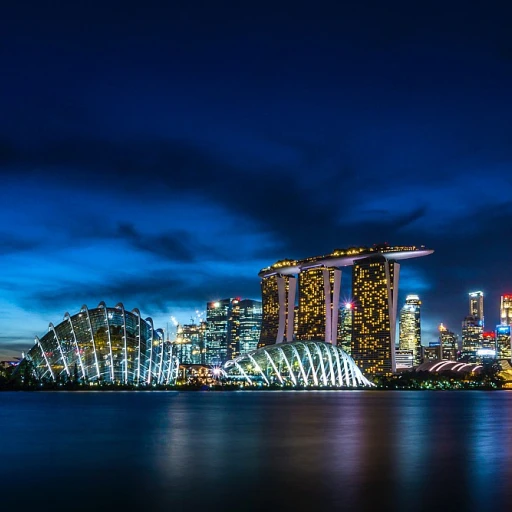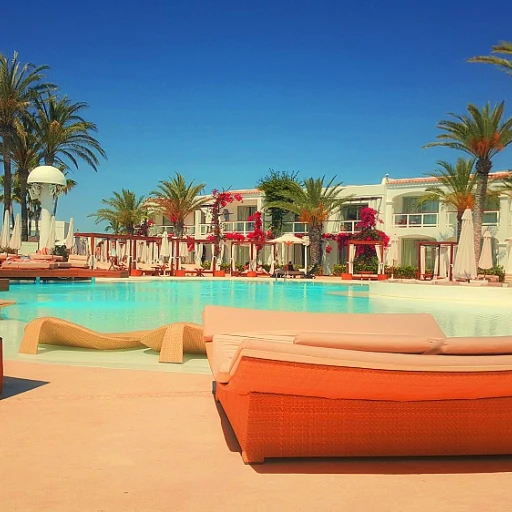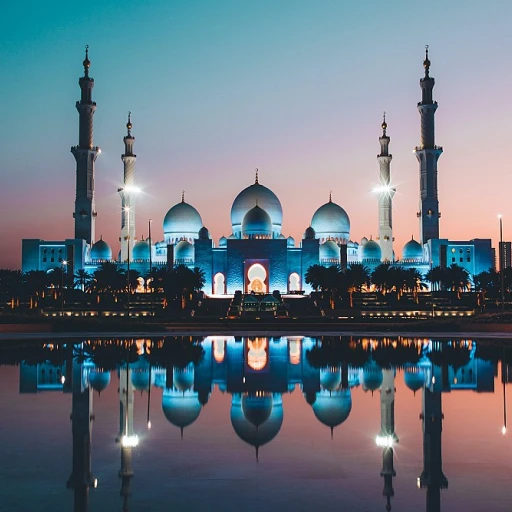The historical significance of reeperbahn
An extraordinary storied past
The Reeperbahn, lying in the heart of Hamburg's St. Pauli district, has a fascinating history that dates back centuries. Originating in the 17th century, this infamous street started as a rope-making district, essential for the Hamburg maritime industry. The name 'Reeperbahn' itself is derived from the Low German word 'Reep,' which means rope, and 'Bahn,' which translates to track or path. This humble beginning laid the groundwork for one of Germany’s hottest nightlife hubs. During the industrial boom of the 19th century, the Reeperbahn began transforming into a center of entertainment. The district's proximity to the harbor made it a crucial stop for sailors seeking refuge and recreation, thus birthing numerous pubs, taverns, and brothels. By the early 20th century, the Reeperbahn had gained notoriety for its adult entertainment offerings, turning it into what it is now often referred to as Europe’s “most sinful mile.” Hamburg's resilience during and after World War II is visible in the Reeperbahn's survival and transformation. Despite severe bombing, the district was promptly rebuilt, slowly reconstructing its reputation. During the 1960s, the area's vibrant arts scene began taking shape with theaters such as the Operettenhaus and clubs that catered to emerging musical talents. Its relocation of the famous Star-Club further immortalized the street as a magnet for musicians and thrill-seekers. In the post-war years, the Reeperbahn's mix of risqué nightlife and musical innovation created a distinctive subculture. By the 1980s, as Germany began embracing greater social freedoms, the Reeperbahn blossomed into a diverse entertainment district, featuring not just erotic showcases, but versatile amusements ranging from music venues to fine dining. It’s a historical mélange - a testament to Hamburg's adaptive spirit through changing times. For those deeply intrigued by this rich history, a visit to Hamburg doesn't just end with St. Pauli. Exploring further might lead you to Universal Studios Japan tickets [/blog/everything-you-need-to-know-about-universal-studios-japan-tickets], providing another layer of adventure and excitement.The beatles' connection to reeperbahn
When the Beatles made history in hamburg
Reeperbahn isn't just another street in Hamburg; it's a place where legends were born. One such legendary tale belongs to The Beatles. Before they became the global icons known to all, John Lennon, Paul McCartney, George Harrison, and Ringo Starr cut their teeth in the vibrant, gritty clubs of the Reeperbahn.
Back in the early 1960s, the young Beatles played their hearts out at various venues along the Reeperbahn, most notably at the Star-Club. This period was transformational for them. As John Lennon once quoted, 'I might have been born in Liverpool, but I grew up in Hamburg.' It's fascinating to think about how these intense, formative years helped shape the band's sound and stage presence.
They played over 250 nights in Hamburg between 1960 and 1962, a fact that should give any music enthusiast chills. You can still visit Indra Club, Kaiserkeller, and Top Ten Club, where the Beatles performed regularly. These clubs have become pilgrimage sites for Beatles fans from across the globe.
According to John Lennon, their time in Hamburg was grueling yet remarkably beneficial. The band's repertoire expanded drastically, and they developed the stamina essential for enduring tours. Each club holds its own magic, making it an integral part of Beatles lore.
For those curious to trace the Fab Four's footsteps in Hamburg, there's even a Beatles-Platz, an iconic square featuring metal sculptures of the band members. It's a must-visit for anyone wanting to truly experience the musical heritage embedded in the Reeperbahn.
Famous clubs and music venues
Legendary clubs and unforgettable music venues
Here's where the Reeperbahn really lights up. Known for its energetic nightlife, the Reeperbahn in Hamburg is brimming with clubs and music venues that have etched their names into the annals of music history. One of the most iconic spots is the Star Club, famously known for hosting the Beatles between 1962 and 1964. During these formative years, the Beatles honed their craft and laid the groundwork for their global superstardom.Another gem is the Mojo Club, a venue synonymous with Hamburg's vibrant music scene since the 1990s. Nestled under the Dancing Towers—a striking architectural feat that adds to the district's allure—this club has seen performances from an eclectic mix of jazz, hip hop, and electro artists. As Konstantin Beck, a local music expert, mentions, “The Mojo Club is a cornerstone of Hamburg's club culture, merging different genres and audiences.”
Let's not forget about the Grosse Freiheit 36. Named after the street it resides on, Grosse Freiheit 36 has been a perpetual hub for live music, hosting gigs by international stars and local talent alike. This venue exemplifies the dynamic range of music you can experience in the Pauli district. From legendary rock icons to contemporary musicians, the energy at Grosse Freiheit 36 is always electric.
For those seeking a slightly avant-garde experience, the Panoptikum wax museum offers a whimsical journey through pop culture. Although not a true music venue, it contributes to the overall eclectic fumes of Reeperbahn, displaying wax figures of famous personalities like the Beatles and Hans Albers.
Every September, the Reeperbahn Festival transforms the district into a hotbed of musical exploration. Described by industry insiders as "the best place for discovering new music," the festival draws talent and spectators from across the globe. Dubbed as Germany's version of SXSW, it offers a myriad of showcases, panels, and networking events, creating an invaluable platform for both emerging and established artists.
The Tivoli Theatre, though primarily an entertainment space, has also been known to host an array of musical acts. Its historical charm adds a nostalgic touch, making it a must-visit spot for any music lover wandering through this storied district.
In wrapping up your tour of Reeperbahn's music hotspots, you'll find that each venue tells its own unique story, weaving together the rich tapestry of Hamburg's musical heritage. Whether you are meandering down the famous Reeperbahn street or catching a late-night gig, the spirit of music is palpable at every turn.
The red light district: myths and realities
Exploring the realities of the red light district
The Reeperbahn, infamously known as one of the world’s most notorious red light districts, holds more than just its reputation as Hamburg’s go-to for adult entertainment. Some may only see the neon lights and red curtains, but there's a lot more under those garish signs.
The roots of the Reeperbahn's association with the sex trade trace far back, cemented in the 18th century. Today, it’s a regulated environment with legal sex work operating under specific guidelines to ensure safety and legality. A statistic that might surprise you is that Germany had approximately 400,000 registered sex workers in 2022, with a significant number working in Hamburg's Reeperbahn area (Source: Spiegel International).
However, there are myths that often sensationalize this aspect of the district. Contrary to popular belief, the area isn't just about sex work. As an article from Deutsche Welle explains, regular nightclubs, theaters, and live music venues pepper the streets, providing entertainment for a wide audience. Even on a night out, you're more likely to find yourself dancing to a DJ set than anything else.
A unique aspect many don't know is that the Reeperbahn actually has one of the lowest crime rates in Hamburg, thanks to strict regulation and the presence of the Davidwache police station, one of Germany's most famous police stations. Staffed 24/7, the station ensures safety and order in what could otherwise be an unruly place. According to a 2018 report, crime in the district had decreased by 20% since 2015, largely attributed to the proactive work of the Davidwache police (Source: FAZ).
The context of the Reeperbahn's red light district would be incomplete without addressing the cultural and societal shifts. Attitudes have evolved, and Hamburg boasts a more progressive stance on these activities, making it a place of openness and acceptance.
For travelers, understanding and respecting this environment is crucial. The energy you feel walking through Reeperbahn at night is electrifying, and while it's true it has a strong adult entertainment presence, it's an experience filled with jovial nightlife, music, and, for many, a picturesque dive into a part of Hamburg's identity that has been both celebrated and scrutinized.
Davidwache police station: keeping the peace
Davidwache: the watchful eyes of reeperbahn
The Davidwache Police Station stands as a historic beacon of law and order amidst the bustling nightlife of Hamburg's Reeperbahn. This iconic building, located in the heart of the St. Pauli district, has been pivotal in maintaining peace since its foundation in 1840. The station's relevance extends beyond its practical purpose; it has cemented itself as a cultural landmark, often featured in books, movies, and TV shows.
History and architecture
The Davidwache is not just another police station; it's an architectural gem. Designed by Fritz Schumacher, it boasts a striking brick façade typical of Hamburg architecture. Over the years, the building has expanded to accommodate growing demands, yet it retains its original charm, blending history with modernity.
The role in public safety
In a district famous for its vibrant nightlife, the need for vigilant law enforcement is paramount. The Davidwache Police Station takes on this role with robust staffing and advanced surveillance technology. According to a report by the Hamburg Police Department, the station handles nearly 16,000 cases per year, ranging from petty theft to serious crimes.
Cultural significance
The Davidwache is more than a police station; it symbolizes the convergence of law and culture. It frequently appears in local folklore and has been immortalized in various works of art. Even the Beatles had to make regular stops here during their early days in Hamburg, usually for their notorious escapades on the Reeperbahn.
Quotes from the force
Police Officer Hans Albers, a veteran at Davidwache, notes, “Our job is not just to enforce the law but to preserve the unique atmosphere of the Reeperbahn while ensuring everyone's safety.” His statement underscores the delicate balance between maintaining order and nurturing the district's spirited essence.
Statistics to consider
- On average, one officer is assigned to every 300 meters of the Reeperbahn street on busy nights.
- The station oversees more than 2,000 nightlife establishments, including bars, clubs, and shops.
- In 2022, the station reported a 5% decrease in theft and a similar reduction in violent crimes, as per official records.
Davidwache and the community
The Davidwache goes beyond policing; it fosters a sense of community. Regular open-house events allow residents and tourists to explore the station and interact with officers, fostering trust and understanding.
The Davidwache Police Station embodies the heartbeat of Hamburg's famous Reeperbahn, ensuring that the excitement of the St. Pauli district remains safe for everyone.
The reeperbahn festival: a celebration of music
The energy and influences of reeperbahn festival
Reeperbahn Festival, a major cultural event, breathes life into Hamburg's famous Reeperbahn district every September. This festival has become one of Europe's most significant music gatherings since its inception in 2006. Imagine thousands of music fans flooding the streets and clubs of Hamburg Pauli district to immerse themselves in diverse sounds.
The festival is a true celebration, hosting over 600 concerts across 70 different venues including renowned spots like Mojo Club and St. Pauli's iconic Star Club. The Reeperbahn Hamburg Germany event isn’t just about music; it also features art, film, and educational programs, making it a multidisciplinary spectacle.
Music industry experts such as Konstantin Beck have lauded the festival for its unique ability to connect emerging artists with influential industry figures. This event draws talent scouts, managers, and artists not just from Europe but globally, putting Hamburg Reeperbahn on the musical map.
In 2022, the festival attracted over 40,000 attendees, highlighting its widespread appeal. For comparison, these numbers are quite significant, considering similar events usually pull in less attendance within the region. The economic impact on the local district Hamburg is noteworthy, with hotels, bars, and clubs experiencing a surge in business, bolstering the local economy.
A standout feature is the festival's free Reeperbahn street performances, ensuring even casual passersby can taste the musical feast. The atmosphere during this time is electric with people hopping from one club to another, indulging in various music genres. You’ll find everything from rock to electronic, jazz to indie music.
Reviews often highlight the festival's ability to maintain a perfect blend of established acts and fresh talent. A 2021 report by the Hamburg Chamber of Commerce emphasized how the festival not only boosts tourism but also fosters a sense of community and cultural exchange.
Though generally beloved, the festival isn't without controversy. Some Hamburg residents complain about the noise levels and increased traffic, leading to discussions between the city officials and festival organizers to find a balance.
No trip to the Reeperbahn is complete without experiencing this event at least once. Whether it's to support the local clubs or to see your favorite band live, the Reeperbahn Festival embodies the spirit of Hamburg’s vibrant nightlife.
Grosse freiheit: the heart of reeperbahn
Historical landmarks and nightlife
Grosse Freiheit, a street name that literally translates to "Great Freedom," is quintessential to the essence of the Reeperbahn in Hamburg. This street witnesses a fascinating juxtaposition of historical landmarks, music venues, and the vivacious spirit of Hamburg's nightlife, earning Grosse Freiheit a reputation as the beating heart of the district.
Dating back to the 17th century, Grosse Freiheit initially served as an area offering religious freedom to those fleeing persecution. Fast forward to the 20th century, it became a hotspot for cabarets and music halls, evolving into one of the most notorious and celebrated streets in Hamburg. A stroll down Grosse Freiheit reveals iconic venues like the Star Club, which played a pivotal role in the early career of The Beatles. Imagine the echo of their guitars resonating through the very halls that now host modern-day music lovers.
A musical legacy
Arguably, one of the most defining features of Grosse Freiheit is its association with influential music scenes. In its heyday, the Star Club, alongside other clubs like Indra and Kaiserkeller, became the launchpad for many British rock bands, creating an everlasting musical legacy. According to scholar Konstantin Beck from the University of Liverpool, the Star Club was instrumental in shaping the European music scene during the 1960s (Beck, 2018).
Club-goers can also visit the Große Freiheit 36, a venue that continues to host top-tier gigs, to witness first-hand the pulsating heartbeats of global music genres. Mojo Club and the iconic Panoptikum further add to the district’s rich cultural tapestry, blending contemporary music with historical essence.
Entertainment and modern-day charm
Beyond music, Grosse Freiheit brims with a myriad of other entertainment options. Television Tower, Hans Albers’ place – an homage to the famous German actor and singer – and other culturally significant spots anchor the street in both past and present.
A unique aspect of Grosse Freiheit lies in its architectural charm, like the Dancing Towers. Their architectural curiosity captures the street's eclectic vibe, drawing visitors into an exhilarating blend of entertainment, history, and modern allure. Engaging with locals or simply watching the hustle and bustle from cafes enhances the overall experience, offering personal stories that make the visit memorable.
However, Grosse Freiheit is more than just a center of entertainment. It serves as a manageable entry point to understand the broader district of St. Pauli, blending cultural wealth with vibrant nightlife. Visitors seeking a deeper connection with Hamburg's history can find solace in the fact that Grosse Freiheit maintains its iconic status amidst evolving cityscapes.
Tips for visiting reeperbahn
The do's and don'ts for a great night out
When you're heading to the Reeperbahn, for an unforgettable evening in Hamburg's famous entertainment district, there are a few essential pointers to keep in mind. Knowing these tips can enhance your visit and ensure it runs smoothly. Whether you're exploring the dazzling clubs on Grosse Freiheit or curious about the infamous red light district, preparation is key.What to wear
Dressing the part is crucial. A night out on the Reeperbahn is not the night to wear flip-flops or sweatpants. Most clubs and bars enforce a smart-casual dress code, so dress to impress. Comfortable footwear is a good idea, especially if you plan on hopping between venues.Safety first
Don't let the district's lively atmosphere distract you from your safety. Stick to well-lit areas and avoid wandering down alleys. If you do get lost, head to the well-marked Davidwache police station for assistance. Remember, while the red light district is part of the Reeperbahn's charm, it's wise to be respectful and cautious in these zones.Try local delicacies
Hamburg is renowned for its food scene. Before diving into the Reeperbahn's nightlife, fuel up on local favorites like currywurst or fish sandwiches. There are countless eateries around the St. Pauli district offering a taste of Hamburg's best.Bar hopping with a plan
With hundreds of bars, clubs, and music venues like the Mojo Club and the Star Club scattered across the Reeperbahn, having a plan can help you make the most of your night. Do a little research, read reviews, and maybe set out a rough itinerary. Some top picks include the Dancing Towers for a modern vibe or the historic Grosse Freiheit street for a bit of everything.Cash is king
While Germany is known for its advanced banking system, many establishments in the Reeperbahn district still prefer cash. Having enough cash on you can save you from potential headaches at the door of the clubs or bars.Public transportation tips
Getting to and from the Reeperbahn is a breeze thanks to Hamburg's efficient public transportation. The Reeperbahn station is well-connected, making it convenient to get back to your hotel after a night out. Trains run frequently, and taxis are readily available, but always ensure you're using official ones.Respect the local laws
Germany has strict public drinking laws, and while the atmosphere on the Reeperbahn might feel like a party everywhere, it's crucial to drink responsibly and know your limits. Public urination and littering are also enforceable offenses, so keep it clean and respectful.Exploring the Reeperbahn is a thrilling dive into Hamburg's pulsating heart. With these tips in your back pocket, you're set for an evening that's as smooth as it is unforgettable.



-large-teaser.webp)





-large-teaser.webp)


